
|   |

|   |
Malavikagnimitram - Dr. Nita Vidyarthi e-mail: nitavidyarthi@gmail.com Photos courtesy: Sushmita Banerjee May 24, 2021 The popular five act Sanskrit play Malavikagnimitram by Mahakavi Kalidas was staged by Deshapriya Kolkata Cultural Centre in association with the Ministry of Culture and Eastern Zonal Cultural Centre as a dance drama at Rangmanch, the amphitheatre of the latter. Conceived, scripted, choreographed and set to music by Kathak dancer Sushmita Banerjee, the rupaka or natya had the indispensable components of music, both vocal and instrumental and undiluted Kathak with all the elements of the dance form and drama in good measure, presented by the well-trained dancers of the organization. Kalidasa’s intricate workmanship of cleverly connecting basic human feelings with dramatic tension and sensibilities with the beauty and characteristics of nature was the preferred choice of presenting this rupaka of the modern Sanskrit dramatist as compared to the works of his predecessors Bhasa, Saumillakya and Kaviputra. Several requests were also a deciding factor for mounting Malavikagnimitram, the first work of Kalidasa by the organization. 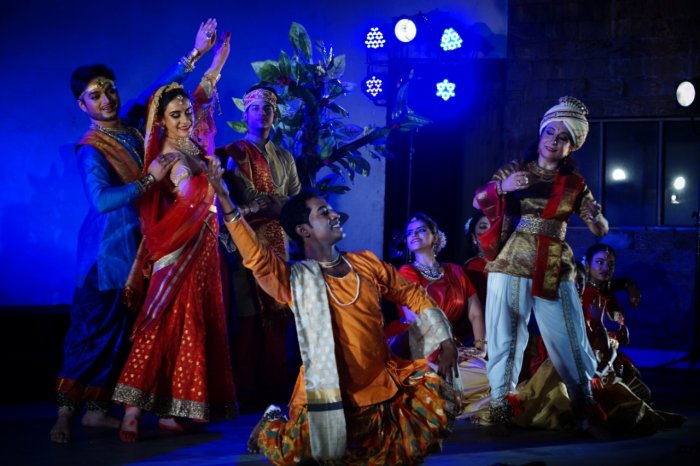 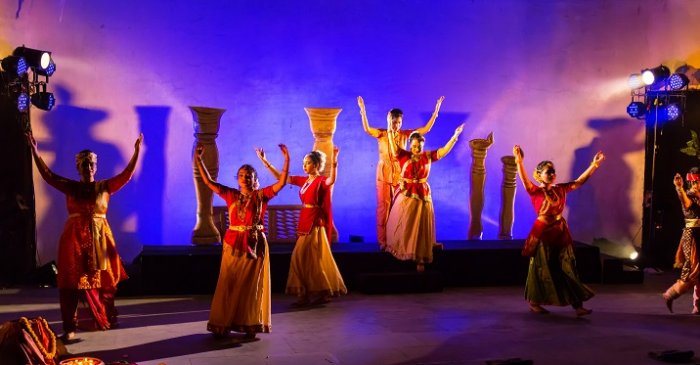 Malavikagnimitram is a court comedy of love between Sunga King Agnimitra of Vidisha and Malavika, the beautiful exiled handmaiden of his chief queen Dharini in the royal palace, amidst the amusing scenes of confusion, confrontation, jealousy, odds, scheming and hurdles in a merry, light-hearted air. It is said that Malavika (Sampurna Sen) was also a proficient dancer and singer in her own right. The play is of special interest because the protagonist King Agnimitra is a historical figure whose father Pushpamitra wrested the kingship of Northern India from the Mauryan King Brihadratha. However, the poet has not weaved in any historical details in his unique romantic and glorious drama embellished with soulful slokas creating an emotionally clever and edgy work that flits across time zones, genres and notions of good taste. Sushmita has not tampered with the elements of the rupaka, the visual poetry or for that matter the abhinaya elements comprising of angika, vachika, aharya and satwika, being portrayed with the required seriousness, format, the emotions, expressions and moods through dance and music. Intelligent designing of the acts beginning with an introduction, with balanced presentation of Hindi narration interspersed with Sanskrit slokas by the Sutradhar sprinkled with chanting woven into the music and dance sequences avoided monotony and provided entertainment and joyous viewing. Further, Kalidasa’s work is particularly a landmark for the introduction of Chhallik (also known as chhalit) nritya, a stylized element of abhinaya - in this case shringara as incorporated in this play by chanting of the sloka: “Padebat Chhalikang naamah, sakshatabhiniyateb, byapadrishya purabrityang, swabhipraya prakashakam, Chaturvida abhinayavat jatiswara samandritam, Shringararasa bhuishtang salayang chhalitang vidhuh.” Incorporation of these slokas elucidating the Chhallik or chhalit nritya and chhalit paath (chhalit chants) and offering an explanation in Hindi of the Chatushpadi sung by Malavika offers a glimpse of a not-so-familiar and an important component that has been introduced by the poet. The invocation was an impressive dance presentation by the group set to the Shiva Stuti “Ekaishwarya stitopi….” followed by the opening act of two dance gurus Ganadas (Debapriya Samanta) and Haradatta (Sangita Sarkar) arguing over their supremacy in the knowledge of dance and drama. Agnimitra had seen the picture of the maiden in Queen Dharini’s chamber and fell in love with the girl. With the help of his friend and confidante Gautam (Binod Kumar) the Vidushak (jester), the King played a game of subterfuge merely to look at the girl. Hence the competition between the gurus was planned by Gautam in which Guru Ganadas chooses his disciple Malavika to represent him. The King was enamoured and enchanted by her beauty and also her performance of Chhallik nritya. The dance sequence at this point of the play between the two gurus placing their arguments sees some defined dancing, especially footwork and nritta exploring delightful complex tala patterns by the skilled dancers doing full justice to the energetic and well crafted choreography. Kalidasa brought in a lot of minute necessities of dance especially in detailing the sequences of the first act of the play. This proves that the poet had an in depth knowledge of dance thereby leaving a strong challenge for the choreographer to do justice to the nuances to unfurl the poetry in the piece and facilitate the understanding of each scene. Director Sushmita Banerjee could discover the eloquence in the multiple emotional situations dictated by Kalidasa’s impassionate slokas and was able to distinguish between theatre and a rupaka and present Malavikagnimitram as an illustration of this ambivalent relationship in some specific moments of the production. 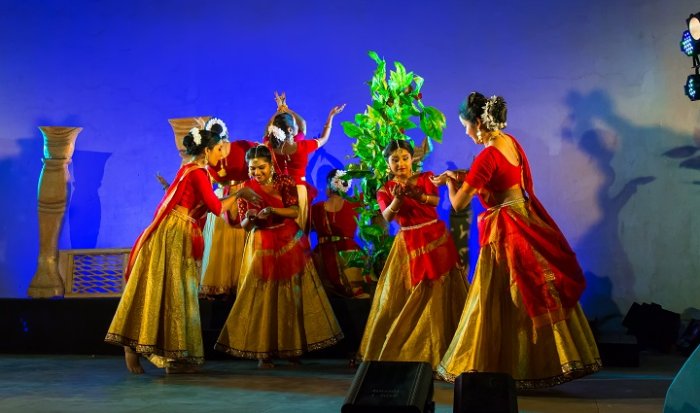 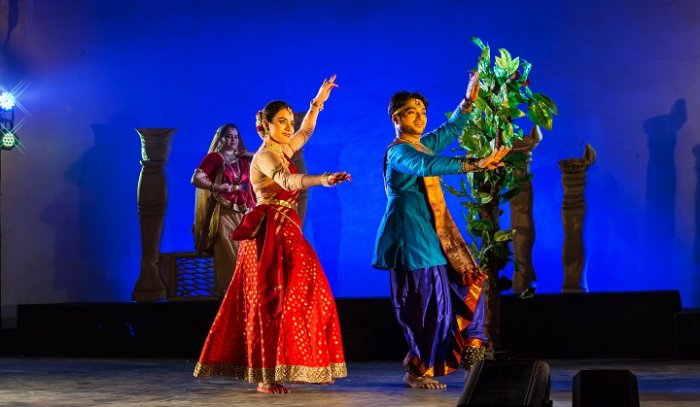 In the second act, the parivrajika (female mendicant) Kaushiki (Tulika Panja) gives a beautiful description of Malavika’s solo dance in detail, emphasizing on her involved rendition with correct depiction of the meaning of the song with proper expressions and graceful movements. Malavika’s teacher Guru Ganadas praises Malavika, her Natya Yajna as Chakshush Yajna (that which is pleasing to the eyes) in comparison to that of Rani Iravati, another queen of Agnimitra and a disciple of Guru Haradatta. The expression of jealousy in Iravati at this point (Rajeswari Mukherjee) in a small role was praiseworthy. Queen Dharini (Chandrani Chandra Pal) hurts her leg and is incapable of performing the Dohad Utsav. Dohad is a ceremony for the prosperity of the kingdom performed by a lady by striking the Swarna Ashoke tree with her foot so that the buds blossom in five days. Dharini sends Malavika and promises her that if the tree blossoms in five days, then she will grant Malavika a wish of hers. The King sees Malavika in front of the Swarna Ashoke and expresses his feelings for her. Dharini gets to know about this and puts Malavika into prison. The Ashoke tree blooms beautifully after five days and the chief queen is now obliged to fulfill one wish of Malavika. Meanwhile, with the help of Gautam, the King is able to free Malavika. Dharini comes to know about the royal lineage of Malavika and knowing that her husband has fallen in love, she makes Malavika as one of his queens. Ace Kathak dancer Souvik Chakravarty rules the stage with his spontaneous rendition as King Agnimitra. His footwork, tatkar, palta and poise especially in thaat is as captivating as ever with a strong grip on rhythm. His duet tarana with Malavika, also a very fine dancer, with a strong technical background, was in perfect in sync and rhythm. Her rendition of the Kavit was stunning. Sushmita as Sutradhar did full justice to her bhavabhinaya with glimpses of movements. Her choreography shows distinction in terms of composition of intricate tala patterns and introduction of intriguing varieties of torhas as does the music and vocals by Susmita Goswami and Sujon Chatterjee. A good measure of sarod by Abhijit Bhattacharya and tabla by Kuntal Das made the potpourri of romantic drama a perfect entertainer. 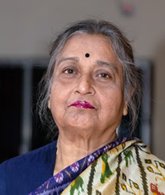 Dr. Nita Vidyarthi is a veteran critic of performing arts and writes on dance, music and theatre in leading publications. |